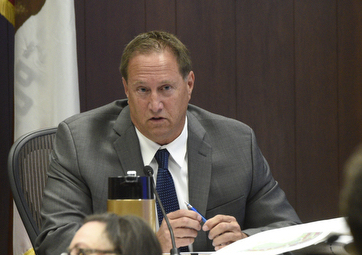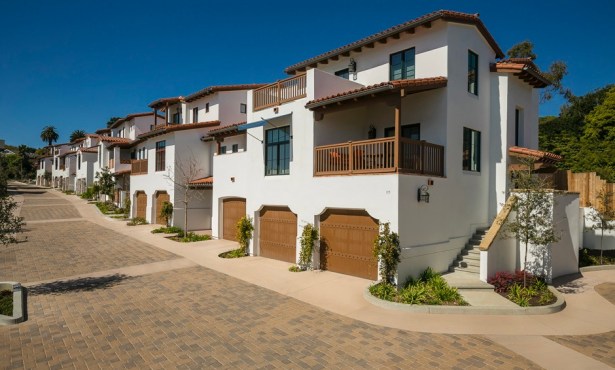Planning Commissioners Grapple With Rental Housing Flaws
Commissioners Tasked With Amending Failing AUD Program

With Santa Barbara’s experimental rental housing program coming to an end, the city is charged with a massive quest — how will it repair the program’s glaring flaws and focus on building affordable rentals? The Planning Commission met for more than five hours Thursday, poring over a 44-page staff report outlining 14 proposed amendments to the program, but they still barely scratched the surface.
“We have 14 meaty concepts here,” said Planning Commission Chair Lesley Wiscomb. “There just isn’t enough time to make any real informed decisions yet.” The commission unanimously voted to pick up the discussion where it left off and formally vote on Thursday, October 17. They must vote on a full list of recommendations in time to present to the City Council at their joint November 14 meeting.
The proposed amendments are for the Average Unit-sized Density program (AUD), which was approved in 2013 as a way to incentivize developers to build more housing by allowing greater building density for rental apartments after the city spent 40 years with few to none built at all. The AUD program has an initial duration of eight years or until 250 new units are constructed. It’s currently six years in, and 223 new units have been built, so the decision to either amend the program or get rid of it entirely is right around the corner.
In addition to the 14 proposed amendments from staff, the commissioners came up with 11 more. They took unofficial votes on each of the 25 total amendments and found unanimous agreement among several of them. They unanimously agreed to add priority overlay to the downtown central business district and along State Street from Arrellaga to Mission streets, but they were split on the idea of removing the priority overlay from the Milpas Street corridor. Commissioners Deborah Schwartz, John Campanella, and Addison Thompson leaned no, and Commissioner Michael Jordan didn’t answer either way.
“You’re basically taking a program that isn’t meeting the numbers in the Milpas area and moving it to the downtown area up to Mission Street,” Commissioner Jordan said. “The cost of land in the business district is more expensive, so I don’t see how moving it will make us rapidly meet the numbers.” The numbers Jordan referred to are the RHNA numbers, or the Regional Housing Needs Allocation. RHNA is a state mandate that requires the city to build a certain amount of rental units by affordability levels, which the AUD program has failed to do.
Although AUD has been successful with getting new units built, they are market-rate and unaffordable, defeating the purpose of the program. For example, the 2019 city-wide median rate for a studio apartment is $1,540 a month, but the studios at Arlington Village (an AUD project) currently run for $2,507 a month. The City Council recently passed a 10 percent inclusionary housing requirement for high-density projects to prevent this in future developments, but more reform is needed.
“I continue to see that one of the big suicidal issues with this is that if we don’t meet our RHNA numbers, it doesn’t matter what else we do,” Jordan said. “The state will just continue to tell us what to do more and more.”
When it came to parking, the commission unanimously agreed to prohibit new tenants from participating in the residential parking program city-wide, meaning that they won’t be given a residential parking permit to park in the areas of the city that only allow drivers 75 minutes to park. All commissioners except Sheila Lodge liked the idea of unbundling parking, which means tenants would have an option to rent their parking space separately from their units. The commissioners were split, though, on the most radical parking idea — allow developers to pay an in-lieu fee rather than build parking at all in the downtown district.
Parking usually costs developers about $30,000 a space, city planner Jessica Metzger explained, so she suggested they pay the city $10,000 a space instead of building parking spaces. It would incentivize developers to build more units, and it would bring renters who currently work downtown to live downtown and either walk or rely on public transportation. Commissioners Jordan and Schwartz were mostly opposed to the idea because it isn’t feasible for families and older people, although it seemed many public commenters of millennial age preferred the idea.
“I’m a millennial; I want to voice my perspective as a young person and say I would definitely support the idea,” said public commenter Daniel Colantonio. “If you have creative ways that would allow young professionals to actually afford living downtown, we would treat it like our home. Right now, the only people treating downtown like a home are homeless people.”
Even older adults with families jumped on board.
“We are very supportive of prohibiting tenants from participating in the parking program,” said Carrie Kelly, the executive director of the Downtown Santa Barbara Organization. “I am married and a mom of a 3-year-old daughter, and we would be happy to forgo a car to live downtown, especially being the director of the organization. Santa Barbara has many public transportation opportunities.”
Perhaps one of the most debated amendments was whether to extend the AUD program itself or just end it entirely. Staff recommended it be extended to “reduce uncertainty in the project entitlement process,” but nearly half of commissioners weren’t on board. Commissioners Jay Higgins and Thompson were hard “nos,” and Jordan didn’t answer either way. Higgins compared the AUD process for developers “like going to France without an interpreter,” and questioned the staff’s conclusion that extending the program would reduce uncertainty for developers.
“We don’t believe we can get any package of ordinance amendments adopted by Council before next summer or fall when the AUD trial period would end,” explained Senior Planner Renee Brooke. “We don’t want the AUD to expire and then revert back to variable density, so we’re proposing extending it as a stop-gap.” The number of applications from developers has declined exponentially in recent years, which the staff attributed to developers’ uncertainty with the program nearing its end.
A large concern of public commenters and commissioners alike wasn’t addressed in the 44-page report: The downtown business district is loaded with historic buildings. They were worried what effect building new rentals in the district would have on some of the historic landmarks, which the city is famous for. Many public commenters suggested block-by-block zoning or additional required setbacks, so that the historic buildings would be preserved.
“Several public commenters brought the same thing I am, just using different language,” Commissioner Thompson said. “If we use form-based codes in the central business district, it would completely take care of the historic resources concern.” Form-based coding is essentially the same as the block-by-block zoning idea that others mentioned, meaning zones are created based on building form instead of land use. The idea was added to the list of amendments, although only Higgins and Thompson himself were in support of it.
“We have thought about the historical resources a lot,” said City Planner Dan Gullett. “Our designated resources come in all shapes and sizes, so to come up with a zoning standard that curates all of them would be difficult. … Our tool is our design boards and design standards that already consider adjacent resources.”
For a full breakdown of the commissioners’ unofficial votes on each of the 25 amendments, see here. The Planning Commission will reconvene October 17 to further discuss the amendments and make an official vote to recommend to the City Council November 14.



